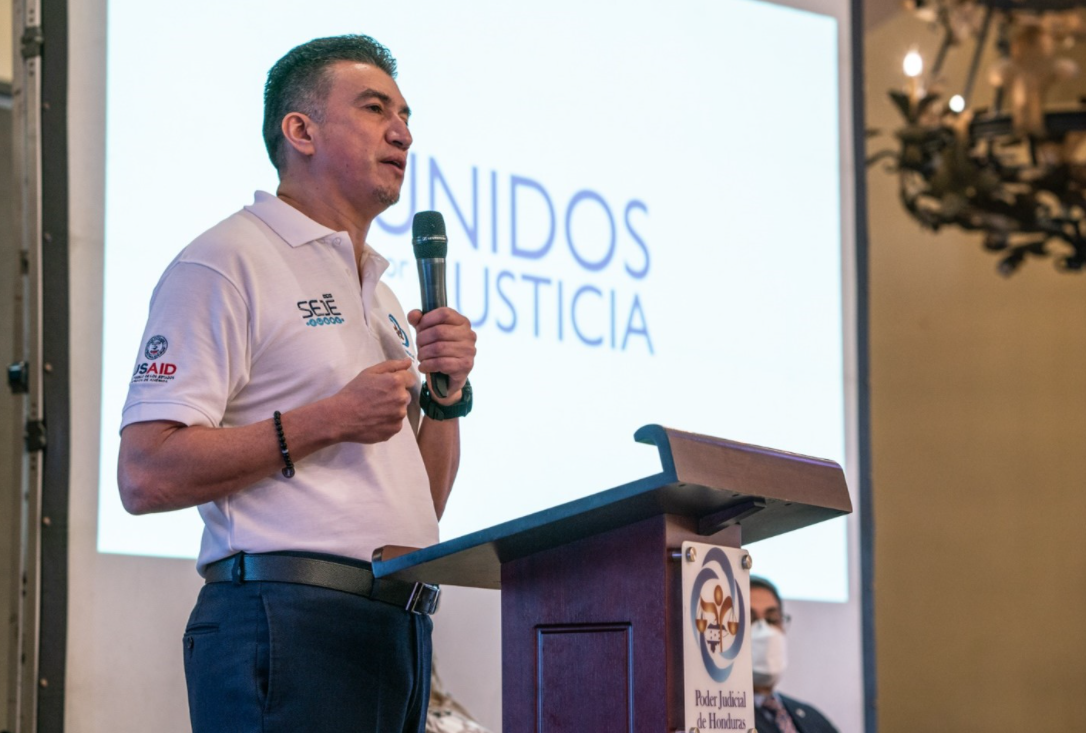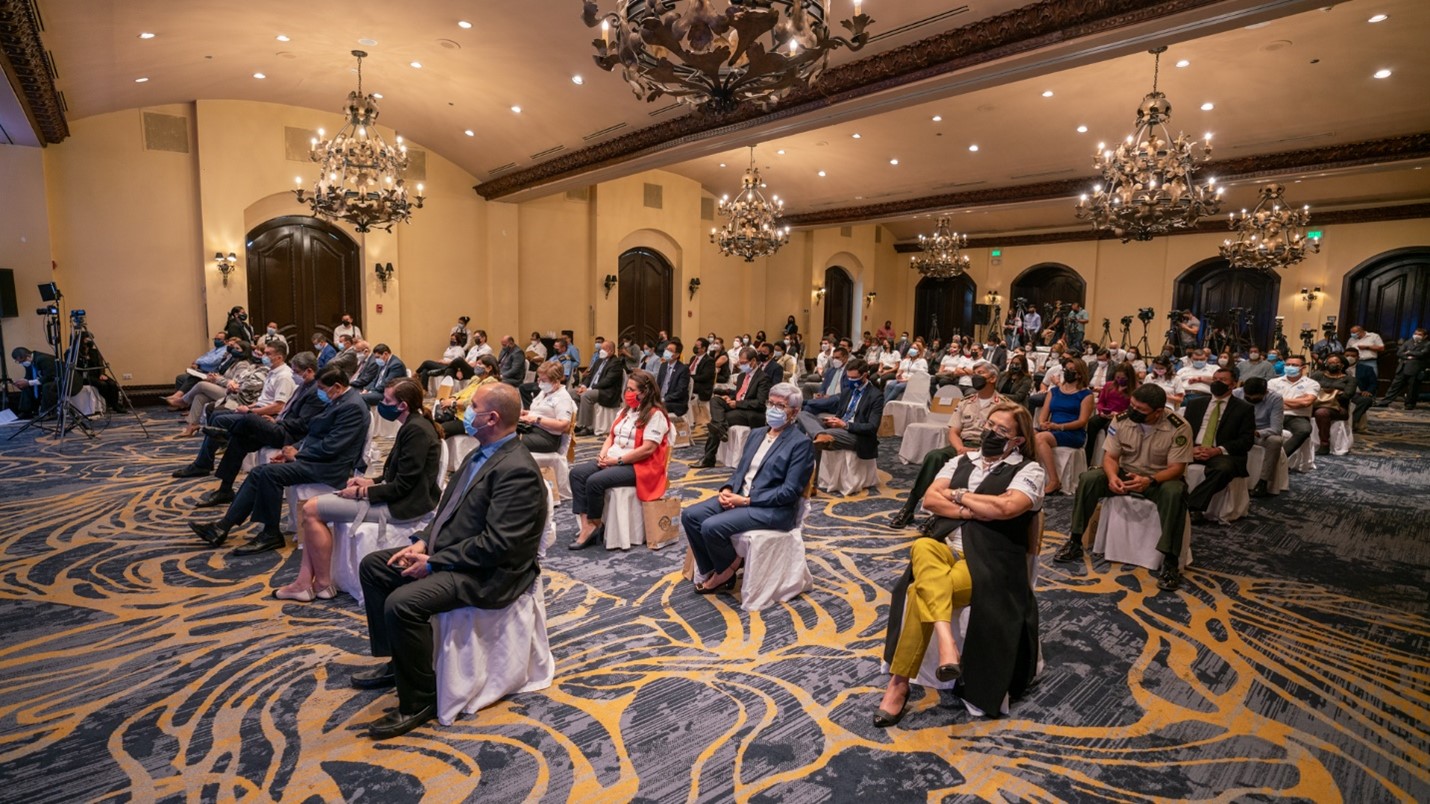
Member Spotlight: Modernized Honduran Judicial System Promises Lower Costs, Increased Efficiency, Safer Communities
Nov. 9, 2021

Chief Justice Rolando Agueta

SEJE Launch Event
By Dan Alder,
Communications Advisor for Unidos por la Justicia | Photos by USAID Unidos project
Despite greater economic stability since 2000, Honduras has
yet to significantly improve living conditions or reduce poverty for much of
its citizenry. The National Autonomous University of Honduras reported that, in
2020, the extreme poverty rate had reached 53.4 percent and the total poverty
rate 70 percent. Some economists have warned that the poverty rate could
increase to 75 percent in 2021 due to the economic crisis caused by the
COVID-19 pandemic, natural disasters, and lack of work opportunities. The
average Honduran living in an urban area faces additional risks such as bus
robberies, indiscriminate homicides, extortion, and other criminal activities
perpetrated by gangs. Along with corrupt law enforcement officials and
political interests that oppose reforms, the rising violence has undermined the
public’s trust in the judicial system.
Against this backdrop, the DAI-led Justice, Human Rights, and Security Strengthening Activity (Unidos por la Justicia)—funded
by the U.S. Agency for International Development (USAID)—works with local
partners to improve citizen engagement with the security and justice sectors,
enhance the efficiency of the judicial system, and increase the effectiveness
of community police.
With support from Unidos and its implementing partner, the
National Center for State Courts, the country’s Judicial Branch recently
unveiled an electronic case file system. Called SEJE for its initials in
Spanish, the system is nothing short of a transformation of the Honduran
justice system. Courts currently use paper case files, which are economically
and ecologically costly as well as logistically difficult and time consuming to
handle. Under SEJE, these case files will be digitized. Digital files are a
more efficient, reliable, and transparent system for processing cases, and will
allow for real-time notification of all relevant parties to a case of court
scheduling, rulings, and other procedures. Digitization will also allow the
Judicial Branch’s statistical and quality control units to collect and analyze
data about case flow, identify bottlenecks, and better measure the performance
of judicial units and individual judges.
SEJE will yield cost savings and make judicial operations
more efficient and transparent. With complex cases now requiring as many as
30,000 folios, savings on paper alone will be significant. In addition to
improving the efficiency of that part of the Judicial Branch responsible for
tackling corruption, SEJE will make court operations themselves more
transparent and therefore less susceptible to wrongdoing. Digital files will be
harder to alter, hide, or misdate due to built-in timestamps and digital
fingerprints left by every user action in the system. Documents that are
legally public will be easier for citizens to access.
“Strengthening access to justice creates hope,” said
USAID/Honduras Mission Director JaninaJaruzelski in her address during the launch event last month. “This
will also help to reduce irregular migration, since citizens will feel safer in
their country.” The overall impact of this innovation will be more efficient
administration of justice and reduced impunity for people who break the law,
summed up Unidos Chief of Party Caterina Valero.
Flagship Project
The creation of SEJE started almost four years ago after
Unidos assessed the technology the Judicial Branch was using at the time. That
assessment resulted in the drafting of a Strategic Innovation and Modernization
Plan, with SEJE as the centerpiece. The Supreme Court Plenary then authorized
the implementation of SEJE and the creation of three groups to oversee it: the
National Coordination Committee (justices of the Supreme Court), a Technical
Committee, and 18 Departmental Committees to coordinate regional
implementation.
The Supreme Court’s approval of the SEJE governance
structure and of the 13 courtrooms where SEJE’s implementation will begin
represents a crucial sustainability milestone because it ensures that permanent
governance bodies will continue to lead this effort beyond the current
president’s tenure, which concludes in January 2023.
As recommended by the Unidos assessment, the Judicial Branch
created an executive committee of information technology (IT) staff and top
administrators tasked with implementation. The committee includes the
institution’s directors of budget and planning, human resources, quality
control, IT, communications, and statistics, reflecting the level of teamwork
required to implement the Strategic Innovation and Modernization Plan.
SEJE’s implementation process is designed to train Judicial
Branch IT staff to maintain and expand on the system without outside help. And
the Judicial Branch has demonstrated its commitment to do just that; it’s
already invested in new technology and hired computer programmers and systems
designers. This institutional buy-in will help ensure the sustainability of
USAID’s investment.
Taking Aim at Corruption
SEJE is now operational in Tegucigalpa’s Extortion Court and
will roll out to the Corruption Circuit Court by the end of the year. Unidos
decided to pilot SEJE in the extortion area because extortion is a major source
of revenue for Honduras’ violent street gangs, robbing small business owners of
the ability to make a living, putting lives at risk, and depressing economic
development. The resulting lack of security and opportunity makes extortion an
important push factor for irregular migration. The Judicial Branch plans to
eventually extend SEJE to the entire court system, but the next stop in the
system’s rollout will be the Corruption Court. While extortion robs people of
their security and the ability to make ends meet, corruption robs them of hope
that their situation will improve.
Another aspect of SEJE designed to bolster people’s security
is its biometric controls module, which replaces the current system for
documenting the compliance of people charged with crimes but granted pretrial
release. Those defendants are obliged to appear periodically before the court
and sign a logbook that is stamped and dated by a court secretary. The
biometric system will instead require a fingerprint scan that is automatically
entered into an electronic court record with a digital timestamp, eliminating
the potential for fraudulent registry entries.
Second Layer
In addition to SEJE, Unidos also supported the creation of
an Electronic Annual Operating Plan (e-AOP), which enables Judicial Branch
managers to track the progress of the Strategic Innovation and Modernization
Plan implementation online, in real time, and link to budgets and expenditures,
a capability that soared in importance with the arrival of the COVID-19
pandemic in Honduras.
“The advantage of this tool is that it brings everything
together in one shared place, allowing us to align our efforts, and all under
the established goals and objectives of the institution and the priorities of
management,” said Judicial Branch Planning and Budget Director Maria José
Laitano. “It allows us to improve all our monitoring and evaluation processes.”
“As of today, this is a shared workspace for only our
administrative offices, but our goal is to be able to implement the e-AOP in
all of our jurisdictional areas,” Laitano added. “It is a big challenge. We
have more than 500 jurisdictional offices on a national level, but we are not
going to rest until we achieve that, because we are convinced that it will be
of great benefit,” she said. Giving everyone easy access to performance data will
engender friendly competition within the court system and result in improved
justice services for the public.
Judicial Branch IT Director Arely Montano is both a primary
protagonist and a big fan of the modernization process now underway. “The
pandemic has crystalized the conviction that technology is key to the
modernization of any institution, and the Judicial Branch cannot allow itself
to lag behind,” Montano said. “The support of USAID Unidos has been a decisive
factor in allowing the Judicial Branch to get behind this process.”